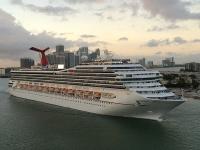 Last Sunday, a fire broke out in the engine room of the 3,299 passenger Carnival Liberty after docking in Saint Thomas. The passengers were disembarked and the fire was extinguished with the ship’s automated fire fighting system. No injuries were reported. The damage was serious enough, however, that Carnival ended the cruise and flew the passengers home. Port calls in Barbados, St. Lucia, St. Kitts and St. Maarten were canceled.
Last Sunday, a fire broke out in the engine room of the 3,299 passenger Carnival Liberty after docking in Saint Thomas. The passengers were disembarked and the fire was extinguished with the ship’s automated fire fighting system. No injuries were reported. The damage was serious enough, however, that Carnival ended the cruise and flew the passengers home. Port calls in Barbados, St. Lucia, St. Kitts and St. Maarten were canceled.
Cruise ship engine room fires have become chronic in recent years, averaging two to three a year over the last decade. “Modern” diesel-electric powered ships seem to the source of most of the fires. The number fires has been small, in absolute terms. Crew members have died in the fires but there have been no passenger fatalities. What is troubling about the fires is the frequency and the relative young age of the ships.
So far this year there have been several smaller fires, not all of which have been widely reported. Royal Caribbean’s Freedom of the Seas experienced a machinery space fire while entering the Port of Falmouth, Jamaica in July. Another Royal Caribbean ship, Jewel of the Seas, had a small fire in February resulting in the ship having no air conditioning for 5 hours and no toilets for at least two.
The fires which have gained the most attention were the cruise ships which were disabled by fire at sea and needed to be towed to port. The Carnival Triumph suffered an engine room fire in February 2013 in the Gulf of Mexico and had to be towed to Mobile, Alabama.
On May 14, 2011, an electrical on failure on the cruise ship MSC Opera cruising in the Baltic, blacked out the ship leaving her drifting for almost three days before tugs arrived and towed her into the Swedish port of Nynashamn near Stockholm.
On November 8, 2010, a fire in the engine room on the Carnival Splendor while cruising in the Pacific off Mexico blacked out the ship and left her drifting without power for four days until she could be towed to San Diego.
Each of theses ships were relatively new and modern designs, powered by diesel electric propulsion systems, with two engine rooms which should have provided significant redundancy to prevent a single fire from backing out a ship. Nevertheless, the ships were left blacked out and drifting at sea. Only following a fire on the MV Azamara Quest was the crew able to restore electricity and propulsion to the ship following an engine room fire.
For a more complete list of cruise ship fires, see Ship Detective’s Passenger Ship Fires 1979 to Current.
Thanks to Irwin Bryan for contributing to the post.

Fun on a combination cattle barge/ container ship, stinking hotel on the water. It’s not a boat experience, it’s a eating and drinking and watching Las Vegas entertainment. Why not GO TO LAS VEGAS instead on cruising on a barf bucket?
I cannot imagine booking a cruise with carnival but I would do so long before I voluntarily went to Las Vegas.
As a former cruise ship officer I would definitely not go with Carnival. There seems to be a design fault with their engines. However I suspect the real problem is due to poorly educated and trained ER personnel the shutdown protocols are not being followed. There is also far to much power concentrated in one group with the Carnival Group owning so many different cruise lines. This certainly effects the USCG applying IMO Rules & Regulations to the Group’s vessels. A clash with Carnival in South Florida means a transfer from the MSO and a “black mark” to a USCG career.
Good Watch
Good Watch.
Pingback: Engine Room Fire on Expedition Cruise Ship Le Boreal, Passengers Evacuated | News For Mariners